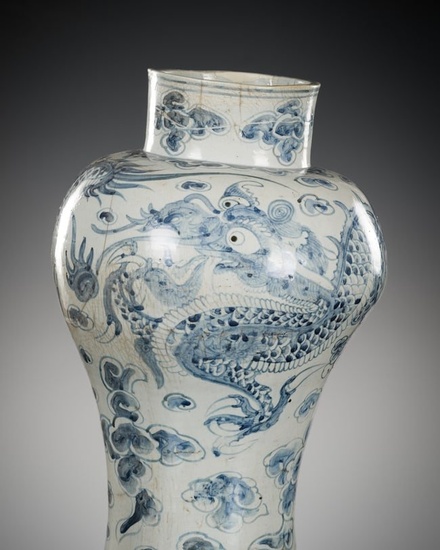A BLUE AND WHITE 'DRAGON' JAR, JOSEON DYNASTY
A BLUE AND WHITE 'DRAGON' JAR, JOSEON DYNASTY
Korea, 18th-19th century. Heavily potted, the baluster body supported on a tapered foot and rising to a tall cylindrical neck. Finely painted to the exterior in shades of cobalt blue with two ferocious four-clawed dragons with sinuous scaly bodies in pursuit of the flaming pearl, below a ruyi border at the shoulder and stylized clouds to the neck.
Provenance: From the personal collection of the late Sir Joseph Hotung. Sir Joseph Edward Hotung (1930-2021) was a Hong Kong businessman, art collector, and philanthropist, famous for his outstanding collection of Chinese jades, porcelain, bronzes, and furniture. Born in Shanghai in 1930, he was the grandson of the tycoon Sir Robert Hotung (1862-1956), known as "the grand old man of Hong Kong", who, by the age of 35, had become the richest man in the territory. A great patron of the arts, Sir Joseph was the first Chairman of the Art Development Council in Hong Kong, endowed lectures and research chairs at universities, and was a trustee of the British Museum, the Metropolitan Museum, the Asia Society, and the Freer Gallery of the Smithsonian Institution. He was knighted by Queen Elizabeth II in 1993.
Condition: Expected wear and firing flaws including kiln grit, firing cracks, and glaze crackling. Old cracks, light scratches, small chips, minor losses, the rim with an old fill. Leaning. Overall displaying remarkably well.
Weight: 9,867 g
Dimensions: Height 49 cm
Porcelain jars decorated with a dragon motif continued to be produced in the Joseon period and were used at court ceremonies to hold flowers, water, or wine. The shape of the jar and the motif of the dragon amid clouds both originated in China, but the loose, spirited drawing, minimum of extraneous decoration, and grayish cobalt color combine to identify this as a Korean piece.
In Korea, dragons are believed to bring good fortune to those they favor, and they also symbolize the authority of the ruler and the balance in nature. Historical records show that during the reign of King Yongjo (r. 1724-1776), dragon jars were the only blue-and-white wares sanctioned for production, as the expensive cobalt blue ore had to be imported from the Middle East through China.
Literature comparison:
Compare a closely related blue and white dragon jar, dated to the late 19th century, 50.8 cm tall, is in the collection of the Brooklyn Museum, accession number 80.120.1.
Auction result comparison:
Type: Closely related
Auction: Christie's London, 18 June 2002, lot 199
Price: GBP 3,346 or approx. EUR 8,500 converted and adjusted for inflation at the time of writing
Description: A Korean blue and white 'dragon' jar, 19th century
Expert remark: Compare the closely related form and similar receding foot, wide eyed dragons, and the rendition of the stylized clouds. Note the similar size (48.9 cm).
Sale price
Estimate
Time, Location
Auction House
A BLUE AND WHITE 'DRAGON' JAR, JOSEON DYNASTY
Korea, 18th-19th century. Heavily potted, the baluster body supported on a tapered foot and rising to a tall cylindrical neck. Finely painted to the exterior in shades of cobalt blue with two ferocious four-clawed dragons with sinuous scaly bodies in pursuit of the flaming pearl, below a ruyi border at the shoulder and stylized clouds to the neck.
Provenance: From the personal collection of the late Sir Joseph Hotung. Sir Joseph Edward Hotung (1930-2021) was a Hong Kong businessman, art collector, and philanthropist, famous for his outstanding collection of Chinese jades, porcelain, bronzes, and furniture. Born in Shanghai in 1930, he was the grandson of the tycoon Sir Robert Hotung (1862-1956), known as "the grand old man of Hong Kong", who, by the age of 35, had become the richest man in the territory. A great patron of the arts, Sir Joseph was the first Chairman of the Art Development Council in Hong Kong, endowed lectures and research chairs at universities, and was a trustee of the British Museum, the Metropolitan Museum, the Asia Society, and the Freer Gallery of the Smithsonian Institution. He was knighted by Queen Elizabeth II in 1993.
Condition: Expected wear and firing flaws including kiln grit, firing cracks, and glaze crackling. Old cracks, light scratches, small chips, minor losses, the rim with an old fill. Leaning. Overall displaying remarkably well.
Weight: 9,867 g
Dimensions: Height 49 cm
Porcelain jars decorated with a dragon motif continued to be produced in the Joseon period and were used at court ceremonies to hold flowers, water, or wine. The shape of the jar and the motif of the dragon amid clouds both originated in China, but the loose, spirited drawing, minimum of extraneous decoration, and grayish cobalt color combine to identify this as a Korean piece.
In Korea, dragons are believed to bring good fortune to those they favor, and they also symbolize the authority of the ruler and the balance in nature. Historical records show that during the reign of King Yongjo (r. 1724-1776), dragon jars were the only blue-and-white wares sanctioned for production, as the expensive cobalt blue ore had to be imported from the Middle East through China.
Literature comparison:
Compare a closely related blue and white dragon jar, dated to the late 19th century, 50.8 cm tall, is in the collection of the Brooklyn Museum, accession number 80.120.1.
Auction result comparison:
Type: Closely related
Auction: Christie's London, 18 June 2002, lot 199
Price: GBP 3,346 or approx. EUR 8,500 converted and adjusted for inflation at the time of writing
Description: A Korean blue and white 'dragon' jar, 19th century
Expert remark: Compare the closely related form and similar receding foot, wide eyed dragons, and the rendition of the stylized clouds. Note the similar size (48.9 cm).



